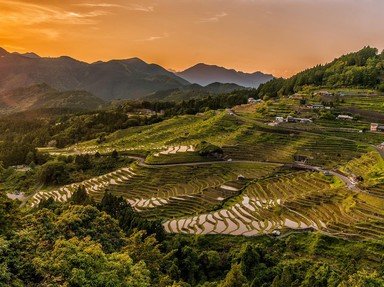Quiz Answer Key and Fun Facts
1. Japan is known as the Land of the Rising Sun. True or false: Japan contains the most easterly point of Asia.
2. Japan is an archipelago of 14,125 islands. How many islands comprise the main islands, also known as the Home Islands?
3. Honshu, the largest island, is also called the mainland. It is one of the top ten largest islands in the world.
4. The size of Japan is deceptive. If the four main islands were superimposed over continental USA, what part would they overlay?
5. Japan is the 61st largest country in the world but being an island country it has a large coastline. Where does Japan rate on the countries with the largest coastlines?
6. Japan is consistently one of the top ten rice producers in the world so one might expect it have a large percentage of arable land. What percentage of Japan is considered arable?
7. Mount Fuji, or more correctly Fujiyama is a Japan's highest mountain and a sacred site. It is also an active volcano.
8. Because of its location on the Ring of Fire, Japan is very susceptible to earthquakes. In 2011 a tsunami created by a deep sea earthquake devastated much of coastal Japan, particularly Sendai and Fukushima. Where are these two places located?
9. Rivers in Japan, because of the mountain terrain, tend to be short and swift. What is the main benefit of such a river system to Japan?
10. Whilst this quiz has concentrated on the physical aspects of its geography, it would be impossible to write a Geography quiz on Japan without a nod to its greatest adaptation to its environment: the railway system.
Shinjuku is the busiest rail station in the world. Given there are over 35 million people in Greater Tokyo, how many people use this station DAILY?
Source: Author
1nn1
This quiz was reviewed by FunTrivia editor
spanishliz before going online.
Any errors found in FunTrivia content are routinely corrected through our feedback system.

